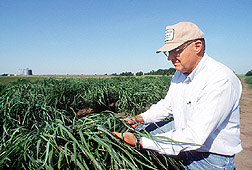This page has been archived and is being provided for reference purposes only. The page is no longer being updated, and therefore, links on the page may be invalid.
Scientists Study Feasibility of Switchgrass for Energy Production
By Don ComisMarch 10, 2006
Two switchgrass plants per square foot the first year ensures a successful bioenergy crop harvest in subsequent years. That's the threshold level for success established by an economic study by the Agricultural Research Service (ARS) and cooperators on 10 northern Plains farms in Nebraska, South Dakota and North Dakota.
Soil scientist Mark Liebig, at the ARS Northern Great Plains Research Laboratory in Mandan, N.D., worked on the study led by Ken Vogel, a geneticist at the ARS Grain, Forage and Bioenergy Research Unit at Lincoln, Neb.
As an expert in breeding and management of new, higher-yielding varieties of switchgrasses best suited to ethanol conversion, Vogel collaborates with many ARS labs in various regions of the country.
Liebig's contribution to the study was to quantify another potential switchgrass benefit: soil carbon storage. The study is a cooperative project with University of Nebraska economist Richard Perrin.
Switchgrass is a native prairie grass long used for conservation plantings and cattle feed in the United States. Interest in switchgrass ethanol has intensified recently as the federal government gains confidence in its potential as a bioenergy crop because of its wide adaptability and high yields on marginal lands. The northern Plains region was chosen first because the economics seemed most favorable there. Farmers can expect switchgrass yields to be high enough there to produce 100 to 400 gallons of ethanol per acre with current varieties.
Results from the main part of the study--the economics of growing switchgrass for bioenergy--are promising. Those results will be issued in May.
Switchgrass can be converted to ethanol just as cornstalks can. It also can be burned to produce electricity. Growing switchgrass for ethanol could bring new industries to rural areas.
As a perennial plant, switchgrass has the advantage of not needing annual planting and tillage. Skipping these can save soil and energy. It can also reduce sediment and other pollutant losses to waterways.
The study's seedling threshold results are reported in the January issue of Crop Science magazine.
ARS is the U.S. Department of Agriculture's chief scientific research agency.

